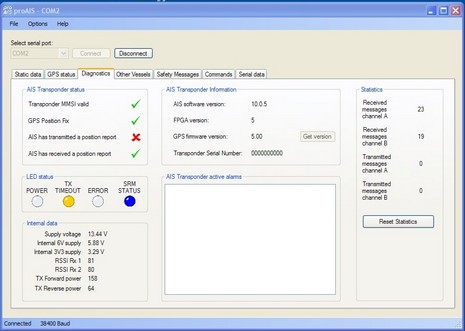TH Class B, & come on FCC!

Back in June the FCC asked for comments regarding Class B AIS units, and several of you—along with the USCG and other safety minded organizations—all encouraged the FCC to approve, or at least waiver, transponders already approved and in use outside the U.S., as soon as possible. There were NO objections. I was not the only one who thought that units like this True Heading would be available shortly after the comment period ended, like now. But they’re not, and recently I heard that there will be yet another comment period and even waivers may not happen until October. How the FCC justifies it glacial pace I have no idea!
So while I can not yet fully test the TH unit here in Maine, today I did get it set up and programmed. It’s quite a rugged beast, encased in aluminum and with all cable connections protected inside a sealed cover, as shown in the photo (bigger here). However the GPS and VHF antenna connectors are more exotic (i.e. European) than the ones used by ACR’s Nauticast B, and the PC port, plotter, and optional Silent Mode/SRM switch are all carried in that one DB9 connector, where the Nauticast B conveniently breaks them all out. The software True Heading supplies (below, and bigger here) is also different than ACR’s; both work fine but each has niceties the other lacks. Then again each seems to work fine with the competitor’s transponder, which I guess is no surprise as both these units use SRT’s circuit board. I also tried both in Silent Mode today—lots of megayachts around—and their receive abilities were similarly good. So I’m ready to do some serious Class B testing on the Bay, when the FCC lets me!














What is being referred to as European connectors look like commercial-grade BNC and BNC and mini-SMC connectors.
I think you’ll find that the connectors on the box are conventional TNC and BNC. On the ends of the flying leads it looks like SMA and BNC, but it is more difficult to tell. Either way, they are standard connectors that can be sourced quite easily.
When I finally got my minimal AIS receiver working here in the Annapolis area, I was a little surprised to see a few targets without names. I’m guessing these were foreign visitors with AIS B transmitters.
I have sailed 1200 nm this summer with the TH CTRX. It works very well and the install was very straight-forward. I use it interfaced with a Nobeltec charting system but it of course works completely independent as well.
It has a BNC-f for the VHF antenna and a TNC-f for GPS. The included short leads provide a BNC-m and TNC-f, if your cables are thicker than the rubber grommet accepts. In what way could they be described as “exotic” or “European”? “Bayonet Neill Concelman” and “Threaded Neill-Concelman” are certainly extremely common, and also superior to the PL connector that should be avoided. Paul Neill of Bell Labs and Carl Concelman of Amphenol would be offended…
The unit ships with a DC/data cable that is used for basic installs, providing bare leads for DC supply and a DB9 RS232 serial connector. If You need the additional RS422 NMEA in/out connections you can add them in the DB15 connector or make your own cable.
There are already around 100 ClassB transponders in Scandinavian waters. The range between 2 ClassB is around 10nm with mast mounted antennas, less with motorboats or pushpit mounts.
BR
/Marcus